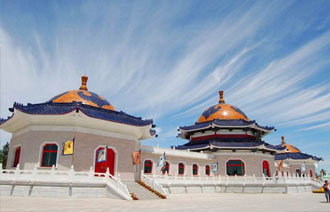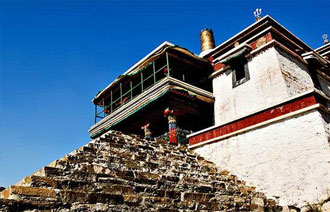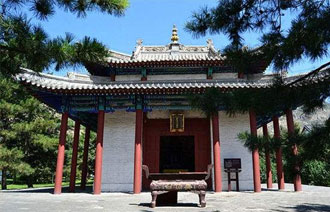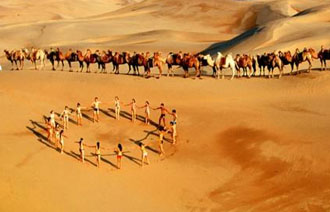
Genghis Khans Mausoleum
 Genghis Khan, "Khan of Khans", was the great leader of Mongolians. At the end of 12th century, he united Mongolian tribes and challenged other powers to expand his huge Mongolian empire, which extended from South China to the Caspian Sea. In 1277, Khan attacked the West Xia Kingdom (presently Ningxia) and encountered strong resistance. He died of disease and age. The great emperor was later buried secretly according to Mongolian custom. It says that after the burial 2,000 men were slaughtered by some 800 soldiers who were in turn executed so that the location of the real tomb remains a secret.
Genghis Khan, "Khan of Khans", was the great leader of Mongolians. At the end of 12th century, he united Mongolian tribes and challenged other powers to expand his huge Mongolian empire, which extended from South China to the Caspian Sea. In 1277, Khan attacked the West Xia Kingdom (presently Ningxia) and encountered strong resistance. He died of disease and age. The great emperor was later buried secretly according to Mongolian custom. It says that after the burial 2,000 men were slaughtered by some 800 soldiers who were in turn executed so that the location of the real tomb remains a secret.
Wudangzhao Lamasery
 Located about 70km to the northeast of Baotou, the 250-year-old Lamasery is the largest of its kind in western Inner Mongolia. The style of Buddhism that is practiced here, of the Yellow Hat Sect (Gelukpa), has a strong following in Mongolia, ever since the Mongols invaded Tibet in the thirteenth century, and nowadays this area still attracts pilgrims in a multitude. The Lamasery is named Wudangzhao, literally Willow Lamasery in Mongolian, because the area around the temple has long been covered by these wispy trees. The original name of Wudang temple is Badager temple. The word of Badager in Tibetan language means white lotus.
Located about 70km to the northeast of Baotou, the 250-year-old Lamasery is the largest of its kind in western Inner Mongolia. The style of Buddhism that is practiced here, of the Yellow Hat Sect (Gelukpa), has a strong following in Mongolia, ever since the Mongols invaded Tibet in the thirteenth century, and nowadays this area still attracts pilgrims in a multitude. The Lamasery is named Wudangzhao, literally Willow Lamasery in Mongolian, because the area around the temple has long been covered by these wispy trees. The original name of Wudang temple is Badager temple. The word of Badager in Tibetan language means white lotus.
Meidai Lamasery
 Meidai Lamasery, lying in Tumd Right Banner at the southern foot of Daqing Mountain, was built by Longqing Emperor Altan khan, chief of Tumd Mongolian Tribe of the Ming Dynasty. The Lamasery is, in fact, the combination of a town and a temple. It is some 50 km away from Baotou City. In the region of Longqing, Altan khan accepted the bestowed title of "Prince of Shunyi," he built the town and the temple. In 1575, the first town and temple was completed, and the royal court bestowed name of Fu'hua. In 1606, the missionary named Maidalihutukertu came to do missionary work here, so it is also called Maidali temple with a circumference of 681 meters, and has an area of 400,000 sq. meters. Clay combined with stones forms the wall of the city, the total length of which is 681 meters, forms a rectangle shape.
Meidai Lamasery, lying in Tumd Right Banner at the southern foot of Daqing Mountain, was built by Longqing Emperor Altan khan, chief of Tumd Mongolian Tribe of the Ming Dynasty. The Lamasery is, in fact, the combination of a town and a temple. It is some 50 km away from Baotou City. In the region of Longqing, Altan khan accepted the bestowed title of "Prince of Shunyi," he built the town and the temple. In 1575, the first town and temple was completed, and the royal court bestowed name of Fu'hua. In 1606, the missionary named Maidalihutukertu came to do missionary work here, so it is also called Maidali temple with a circumference of 681 meters, and has an area of 400,000 sq. meters. Clay combined with stones forms the wall of the city, the total length of which is 681 meters, forms a rectangle shape.
Resonant Sand Gorge
 The Resonant Sand Gorge, located 50km south of the city proper, is more a place of natural beauty than of historical importance. The Gorge is a part of the vast Gobi desert that starts just to the south of Baotou and that spreads over Inner Mongolia, Gansu, Qinghai, Ningxia and Xinjiang provinces. The sand gorge is a not easily accessible area of numerous sand dunes that rise up to levels of over 90 meters. It receives its name from the echoing Shhhh that the sand makes as you step on its surface. Visitors here can try camel rides, can parasail, can slide the dunes or simply build sand castles.
The Resonant Sand Gorge, located 50km south of the city proper, is more a place of natural beauty than of historical importance. The Gorge is a part of the vast Gobi desert that starts just to the south of Baotou and that spreads over Inner Mongolia, Gansu, Qinghai, Ningxia and Xinjiang provinces. The sand gorge is a not easily accessible area of numerous sand dunes that rise up to levels of over 90 meters. It receives its name from the echoing Shhhh that the sand makes as you step on its surface. Visitors here can try camel rides, can parasail, can slide the dunes or simply build sand castles.

